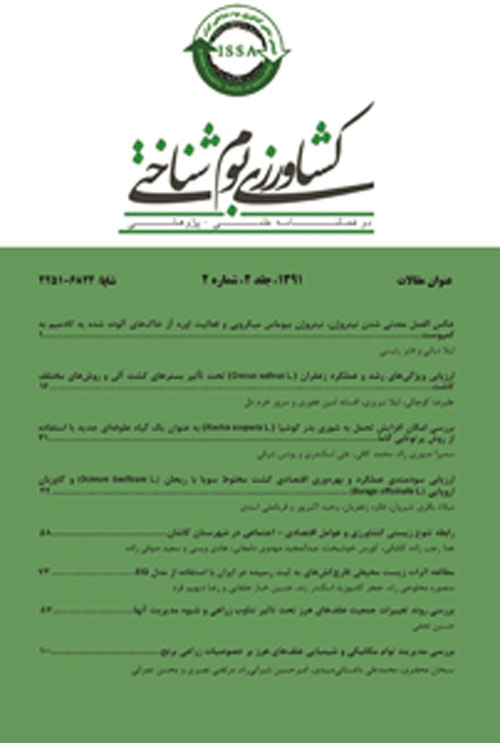Evaluation of multi-species weed interference with rainfed lentil (Lens culinaris L.) in natural field conditions
Author(s):
Article Type:
Research/Original Article (دارای رتبه معتبر)
Abstract:
Introduction
Lentils are one of the most important legumes in agricultural systems. Unfortunately, they compete poorly with weeds due to morphological characteristics. Weed control is therefore necessary to prevent yield loss. Yield is not generally affected by single-species weed interference but the presence of several different weeds leads to reduced crop yields (Song et al., 2017). Therefore, the study of multi-species weed interference provides useful information at the field level. Regarding the material mentioned in this study, the interference of multi-species weeds with lentil in natural field conditions was investigated.Materials And Methods
This experiment was conducted on one of the lentil fields of the Agricultural and Natural Resources Campus of Razi University in Kermanshah. Sampling was systematically carried out in two stages in a network of regular points with 7-meter spacing using a 1-square meter quadrate. The geographic coordinates of each sampling point were recorded using a GPS device. The first stage of non-degraded sampling was done at the the pre-flowering stage of lentil and recorded density, height and the percentage of weed canopy and lentil canopy. The second stage of sampling was carried out precisely at the same points of the first sampling. The recorded variable in this stage included dry weight, weed density, and lentil yield. Relationship between weed density, canopy percentage and height with lentil yield were investigated using regression function.Results And Discussion
The results showed that the regression relationships between weed density, canopy percentage and height with the lentil yield were significant (p≤0.01) and the function was able to express the variations of the dependent variable affected by independent variables. According to the model, lentil yield was significantly affected by weed density and canopy percentage (p≤0.01). Thus lentil yield decreased with increasing weed density and canopy percentage with decreasing coefficients of 0.62 and 0.67T respectively. Weed height did not show a significant effect on yield. Correlation coefficients between weed density and lentil yield indicated that there were significant negative correlations between three weeds of high density including Chenopodium album, Polygonum aviculare and Sinapis arvensis with lentil. In a study about the relationship between weeds and autumn wheat, researchers also reported that just three species of the seven weed species in the field had a negative effect on wheat yield (Noroozi et al., 2003). Mean comparison of lentil yield affected by different levels of weed canopy indicated that the effect of the weed canopy on lentil yield was significant. The highest yield was observed when the weed canopy was 0-10% and the lowest when the weed canopy was 60-70%. Investigating the relationship between weed canopy percentages and lentil yield showed that there were significant negative correlations between the four weeds including Sinapis arvensis, Picnomon acarna, Cerastium perfoliatum, and Convolvolus stachydifolium with yield. In general, the different levels of weed canopy percentage had a significant effect on lentil yield. The yield showed a decreasing trend with increasing weed canopy percentage. Research has also shown that plants are affected by increasing canopy levels of adjacent plants (Cressman et al., 2011).Conclusion
The results of the study indicated the significant effect of weeds on lentil yield, so that increasing the density, weed density, and canopy can reduce yield. The results also showed that weeds can have negative or positive effects on crops. Among weeds registered in the field, only a few weed species had a significant negative effect on lentil yield. Keywords:
Language:
Persian
Published:
Journal of Agroecology, Volume:8 Issue: 1, 2018
Page:
91
magiran.com/p1846619
دانلود و مطالعه متن این مقاله با یکی از روشهای زیر امکان پذیر است:
اشتراک شخصی
با عضویت و پرداخت آنلاین حق اشتراک یکساله به مبلغ 1,390,000ريال میتوانید 70 عنوان مطلب دانلود کنید!
اشتراک سازمانی
به کتابخانه دانشگاه یا محل کار خود پیشنهاد کنید تا اشتراک سازمانی این پایگاه را برای دسترسی نامحدود همه کاربران به متن مطالب تهیه نمایند!
توجه!
- حق عضویت دریافتی صرف حمایت از نشریات عضو و نگهداری، تکمیل و توسعه مگیران میشود.
- پرداخت حق اشتراک و دانلود مقالات اجازه بازنشر آن در سایر رسانههای چاپی و دیجیتال را به کاربر نمیدهد.
In order to view content subscription is required
Personal subscription
Subscribe magiran.com for 70 € euros via PayPal and download 70 articles during a year.
Organization subscription
Please contact us to subscribe your university or library for unlimited access!



